Meal 58: Fiji
We had been planning this meal with 18 Reasons, a warm and welcoming non-profit community food space in San Francisco, for almost a year. Taking the day off of work to prep and cook with my parents, the larger audience of friends new and old, and the gorgeous organic ingredients from Bi-Rite Market all contributed to a special and gratifying experience. But didn't really hit me how this meal was operating on an atypical plane until one of the volunteers very politely asked if there was enough food that they could try a bit. Two full-on staff helping to serve dishes, pour wine and wash up, without even the expectation of joining us at the table, was a first for this amateur chef. 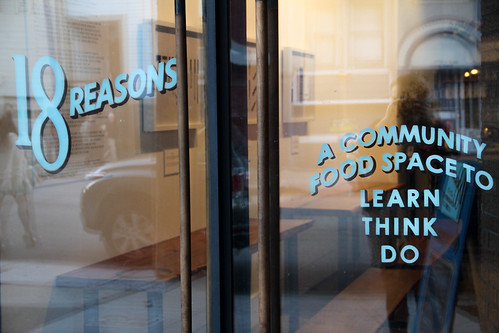
Not only was the setting unique, but this was first adventure into the islands of the Pacific, a region rich in root vegetables, tropical fruits, seafood — and in the past several decades, canned meat. Thanks to a large Indian population, courtesy of British colonial practices a century and a half ago, Fiji's cuisine has a strong fusion streak, with the spices and techniques of South Asian cooking. I found most of what I needed, including citrus (50 limes!), coconut milk (7 cans!), and some beautiful fresh fish, at 18 Reasons' parent market, Bi-Rite. We did have to adventure to the appropriately named Fiji Market in nearby San Bruno for taro, kava, and canned corned beef.

We had a really wonderful time, with a fun cross-section of friends we knew, members of the 18 Reasons community, and others who'd heard about us. The spirit of getting to know food, culture, and each other through shared experience, that we and 18 Reasons both celebrate, shone through brightly. We owe a huge thanks to Olivia, the program coordinator, who not only made sure things ran smoothly and that we kept on schedule, but brought an awesome blend of hospitality and helpfulness that made us feel right at home in the unfamiliar surrounds of a commercial kitchen.
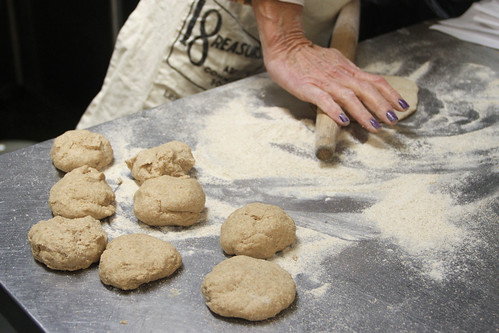
Kokoda | Coconut milk ceviche | Recipe
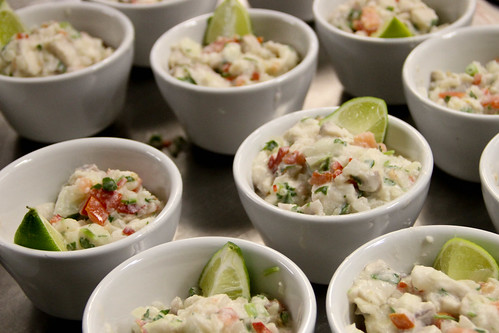
This dish is pretty much as excellent as it sounds. The types of fish the recipe recommends were either prohibitively expensive or unsustainable, so we went with local rockfish, which worked out great. The only challenge in making this dish is not feeling sad when you have to drain the acid-cooked fish of all that lime and lemon juice you hand-squeezed! (But don't worry, plenty of that citrus flavor remains. And you don't have to pour out every last drop.) This is a great dish to make ahead for a party, and if you like it spicy feel free to liven it up a bit more than we did.
Curried sweet potato and banana salad | Recipe
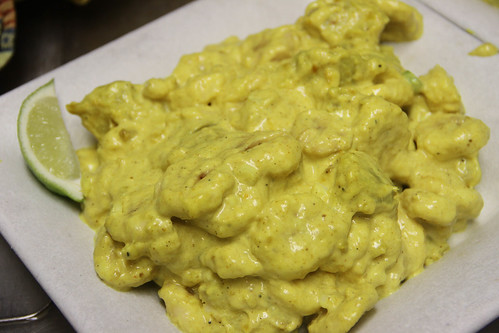
It sounds strange, and looks unappetizing, but this dish is a real winner. Bananas and baked sweet potatoes, which I've never seen together in a dish, have a similar mushy texture and earthy sweetness that complement each other quite well. The garlic and curry powder provide a robust, savory counterbalance, which is enlivened by sautéeing the two together to release the flavors and colors of the powder into the oil while making the garlic a bit nutty. (I just learned that this technique is core to Indian cooking, and called chaunk). The seasoning is mixed with a generous hunk of mayonnaise and folded to coat everything. I imagine this lasts long in the fridge; we wouldn't know as it was all gobbled up, the blend of sweet, creamy, and turmeric-heavy spice proving too much to resist.
Palusami | Corned beef and coconut milk baked in taro leaves | Recipe
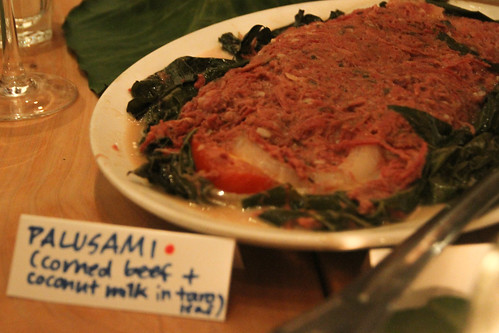
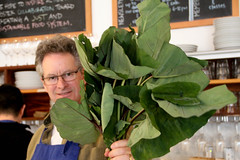
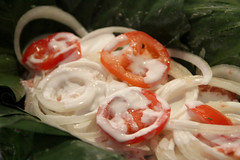
Steamed taro

This fairly bland and starchy tuber is very high in oxalic acid, the same chemical that makes the back of your teeth feel dry after eating a bunch of spinach. Some people even need to use gloves to handle it so their skin doesn't get irritated. There are a lot of ways to cook taro, and in Fiji they tend to steam it. The kitchen didn't have a true steaming setup, so we improvised, and apparently undercooked, because some people got itchy mouths and throats from it! Lesson learned.
Coconut chutney | Recipe

I might call this more of a slaw or a salad, since it doesn't really resemble either the syrupy or soupy, tangy, highly spiced condiments we're used to carrying that name. Call it what you may, a little pile of this limed-up coconut shred definitely added some flavor and intrigue to the taro. (Also, gotta say this coconut was a lot easier to break and separate from the shell than most I've used, maybe it was fresher than what I normally find?)
Squash and chana dhal | Summer squash and yellow lentil stew | Recipe
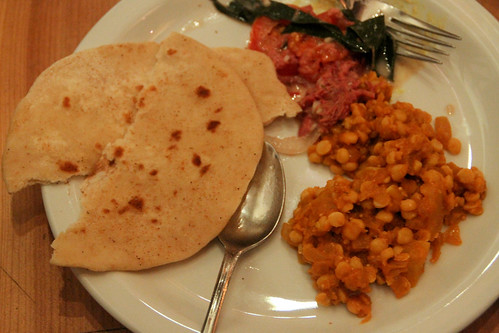
I chose this dish partly to accommodate the vegetarians, but also to more wholly represent the Fiji-Indian population. This recipe is a pretty good dhal, not too hot but with a good variety of spices. The squash is a novel addition; in my experience with Indian food, generally a dhal is pretty much legume and onion, with no other vegetable sharing the stage. It would seem I made one error, though: after cooking this dish, I discovered that "chana dhal" is peeled split black chickpeas/garbanzos and commonly used in India, whereas in Fiji, this dish would have been made instead with yellow split peas. My guess is the Fijian dish would probably have been a bit softer and not cooked for as long, but I think this one still turned out quite well.
Roti | Indian flatbread | Recipe
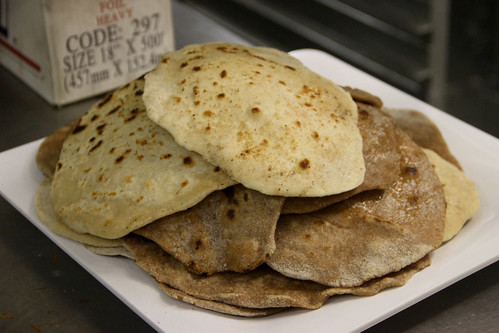
Guess what: if all you've got is 20 minutes, some flour, and optionally a bit of butter, you can make bread! Roti is really as simple as it gets: mix flour with water until it's a decent dough; knead it a bit, then roll it into rounds on a floured surface; then cook for about a minute on each side on a pan or griddle. The butter, added once the roti hits the grill much as you'd put blueberries in a pancake, makes it tastier but isn't necessary. (The variation in colors in the photo is due to the fact that we made them with whole-wheat flour until we ran out, and then turned to white flour.) Huge thanks to our friend Felicity for showing up, strapping on an apron, and jumping in to help my mom whip up a few dozen just in time for dinner!

Cassava cake | Recipe
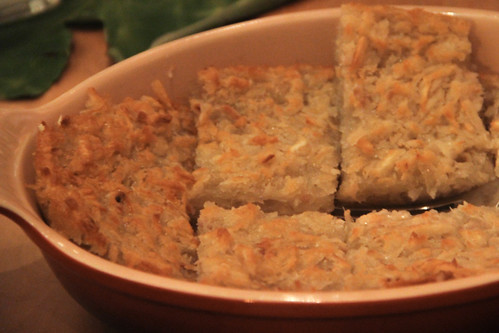
Throughout the world, we've seen cassava prepared so many ways — steamed, boiled, sauteed, fried, powdered, fermented — and you've surely had it as a dessert at some point in the form of tapioca pudding, but never have I seen this flexible and widespread root in its solid form. The ingredient list is so simple, basically just cassava, sugar, and coconut milk, though it does take labor to peel and grate the root and then squeeze it to extract liquid while retaining starch. But it's a very forgiving recipe, you can tweak the proportions to your taste, and cooking it for a few minutes more or less will pretty much just affect how brown the top is. After a meal with some pretty odd flavor combinations, this mildly sweet and moderately spongy-sticky dish was a nice wrapup.
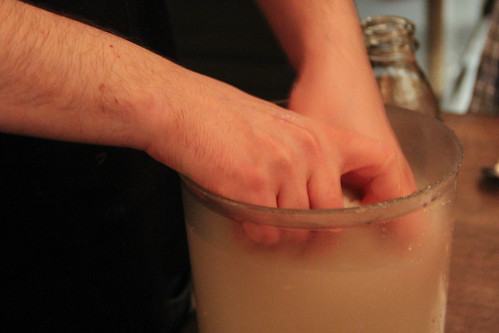
But wait, there's more! A Fijian feast would be quite incomplete without this traditional relaxing drink. We were very lucky to have Monica, a returned Peace Corps volunteer, who taught us how Fijians dry and ferment the root, grind it up, and often drink bowl after bowl. While it's not alcohol, the similarity of the effect leads them to call it "being drunk." It's pretty straightforward to make, just put some amount in cheesecloth, dunk that into water, and massage the lump until your hands start to get numb. It smells no better than mildly decomposed leaves, and tasted pretty bitter, but once the sensation of calm and lethargy starts to hit, it's amazing how easy it is to overlook all that.
18 Reasons generously included local beer (the Fijian stuff doesn't seem to be very good) and some nice, crisp New Zealand sauvignon blanc. Laura pulled together an intriguing playlist, including one type of music that surprisingly combines country, disco, and island sounds in roughly equal proportion. And huge thanks, once again, to the volunteers who spent the evening helping us have such a great time.

We had such a fun time, both in the preparation and the enjoying of the meal, and hope to be able to do more of this sort of collaboration — both with 18 Reasons and other great food-community orgs — in the future!